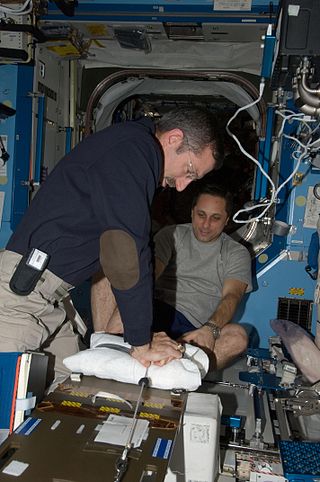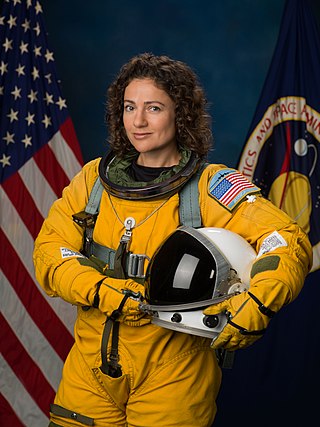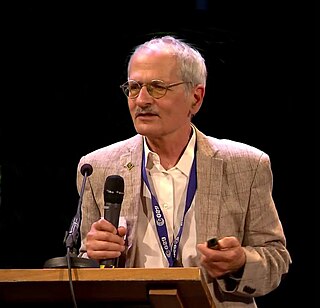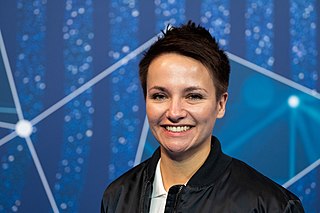
The European Space Agency (ESA) is a 22-member intergovernmental body devoted to space exploration. With its headquarters in Paris and a staff of around 2,200 people globally as of 2022, ESA was founded in 1975. Its 2024 annual budget was €7.8 billion.

Robert Brent "Bob" Thirsk, is a Canadian retired engineer and physician, and a former Canadian Space Agency astronaut. He holds the Canadian record for the most time spent in space. He became an officer of the Order of Canada (OC) in 2013 and was named to the Order of British Columbia (OBC) in 2012.

Dome C, also known as Dome Circe, Dome Charlie or Dome Concordia, located at Antarctica at an elevation of 3,233 metres (10,607 ft) above sea level, is one of several summits or "domes" of the Antarctic Ice Sheet. Dome C is located on the Antarctic Plateau, 1,100 kilometres (680 mi) inland from the French research station at Dumont D'Urville, 1,100 kilometres (680 mi) inland from the Australian Casey Station and 1,200 kilometres (750 mi) inland from the Italian Zucchelli station at Terra Nova Bay. Russia's Vostok Station is 560 kilometres (350 mi) away. Dome C is the site of the Concordia Research Station, jointly operated by France and Italy.

Concordia Research Station, which opened in 2005, is a French–Italian research facility that was built 3,233 m (10,607 ft) above sea level at a location called Dome C on the Antarctic Plateau, Antarctica. It is located 1,100 km (680 mi) inland from the French research station at Dumont D'Urville, 1,100 km (680 mi) inland from Australia's Casey Station and 1,200 km (750 mi) inland from the Italian Zucchelli Station at Terra Nova Bay. Russia's Vostok Station is 560 km (350 mi) away. The Geographic South Pole is 1,670 km (1,040 mi) away. The facility is also located within Australia's claim on Antarctica, the Australian Antarctic Territory.

Space medicine is an area in aerospace medicine that focuses on the medical care of astronauts and spaceflight participants. The spaceflight environment poses many unique stressors to the human body, including G forces, microgravity, unusual atmospheres such as low pressure or high carbon dioxide, and space radiation. Space medicine applies space physiology, preventive medicine, primary care, emergency medicine, acute care medicine, austere medicine, public health, and toxicology to prevent and treat medical problems in space. This expertise is additionally used to inform vehicle systems design to minimize the risk to human health and performance while meeting mission objectives.
The European Astronaut Corps is a unit of the European Space Agency (ESA) that selects, trains, and provides astronauts as crew members on U.S. and Russian space missions. The corps has 13 active members, able to serve on the International Space Station (ISS). The European Astronaut Corps is based at the European Astronaut Centre in Cologne, Germany. They can be assigned to various projects both in Europe or elsewhere in the world, at NASA Johnson Space Center or Star City.

Weightlessness is the complete or near-complete absence of the sensation of weight, i.e., zero apparent weight. It is also termed zero g-force, or zero-g or, incorrectly, zero gravity.

Alexander Gerst is a German European Space Agency astronaut and geophysicist, who was selected in 2009 to take part in space training. He was part of the International Space Station Expedition 40 and 41 from May to November 2014. Gerst returned to space on 6 June 2018, as part of Expedition 56/57. He was the Commander of the International Space Station. He returned to Earth on 20 December 2018. After the end of his second mission and before being surpassed by Luca Parmitano in 2020, he held the record for most time in space of any active ESA astronaut, succeeding Italian astronaut Paolo Nespoli, and German ESA astronaut Thomas Reiter, who formally held the record for the longest time in space for any active or retired ESA astronaut.

Norishige Kanai is a Japanese doctor and JAXA astronaut.
ELIPS - European Programme for Life and Physical Sciences in Space and applications utilising the International Space Station started in 2001 and was intended to cover the activities for the following 5 years. This Microgravity Programme at the European Space Agency (ESA) is an optional programme, with currently 17 ESA member states participating. The ELIPS programme prepares and performs research on the International Space Station, and other uncrewed mission platforms like Sounding Rockets, in fundamental and applied life and physical sciences. ELIPS is the continuation of the earlier European microgravity programmes EMIR 1&2, and the Microgravity Facilities for Columbus, MFC.

Jessica Ulrika Meir is an American NASA astronaut, marine biologist, and physiologist. She was previously an assistant professor of anesthesia at Harvard Medical School, Massachusetts General Hospital, Boston, following postdoctoral research in comparative physiology at the University of British Columbia. She has studied the diving physiology and behavior of emperor penguins in Antarctica, and the physiology of bar-headed geese, which are able to migrate over the Himalayas. In September 2002, Meir served as an aquanaut on the NASA Extreme Environment Mission Operations 4 crew. In 2013, she was selected by NASA to Astronaut Group 21. In 2016, Meir participated in ESA CAVES, a training course in which international astronauts train in a space-analogue cave environment. Meir launched on September 25, 2019, to the ISS onboard Soyuz MS-15, where she served as a flight Engineer during Expedition 61 and 62. On October 18, 2019, Meir and Christina Koch were the first women to participate in an all-female spacewalk.

James R. Kass is a Canadian physicist engaged in the field of human spaceflight.
The following page is a list of scientific research that is currently underway or has been previously studied on the International Space Station by the European Space Agency.
Helmut G. Hinghofer-Szalkay is an Austrian physiologist. He headed the Institute for Physiology, Karl Franzens University / Medical University Graz (2005–2013), was founder and director of a non-profit research lab. He is married to the artist Irma Michaela Szalkay and has two children/
Beth Healey is a British medical doctor who spent a year in Antarctica at Concordia Station, a French-Italian base, as a Research MD. She worked for the European Space Agency, researching the effects of physical and psychological isolation on a group of people. Concordia has been called "The White Mars", the nearest equivalent on earth to the kind of isolation which would be experienced by long-distance space travellers.

Josef Aschbacher is Director General of the European Space Agency (ESA), a position he has held since 1 March 2021. His international career in space combines more than 35 years' of experience at ESA, the European Commission, the Austrian Space Agency, the Asian Institute of Technology and the University of Innsbruck.

The 2022 European Space Agency Astronaut Group is the latest class of the European Astronaut Corps. The selection recruited five "career" astronauts as well as 12 "reserve/project" astronauts. They are the fourth European Space Agency (ESA) astronaut class to be recruited.

Varsha Jain is a British physician known as a "space gynaecologist". She has studied at universities in the UK but with an interest in space medicine. She is a clinical doctor also researching women's health at the University of Edinburgh.

Meganne Louise Wyatt is an member of the 2022 European Space Agency Astronaut Group, and Reserve Astronaut and Exploration Commercialisation Lead at the UK Space Agency.

Amelie Karin Josephine Schoenenwald is a German biologist and reserve astronaut. After studying at the Technical University of Munich from 2009 to 2015, Schoenenwald earned a PhD in integrative structural biology at the Medical University of Vienna in 2020. She was chosen as a reserve astronaut in the European Astronaut Corps in 2022. By the time of her selection, she had worked in industry for a few years.















